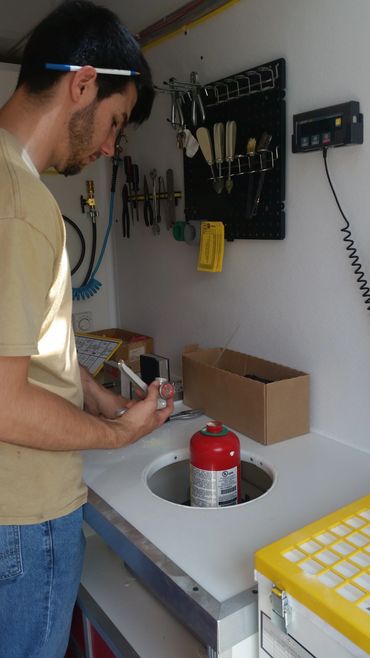Photo Gallery

Inspections & Maintenance
Inspections
- The extinguisher is not blocked by equipment, coats or other objects that could interfere with access in an emergency.
- The pressure is at the recommended level. On extinguishers equipped with a gauge (such as that shown on the right), the needle should be in the green zone - not too high and not too low.
- The nozzle or other parts are not hindered in any way.
- The pin and tamper seal (if it has one) are intact.
- There are no dents, leaks, rust, chemical deposits and/or other signs of abuse/wear. Wipe off any corrosive chemicals, oil, gunk etc. that may have deposited on the extinguisher.
Some manufacturers recommend shaking your dry chemical extinguishers once a month to prevent the powder from settling/packing.
Fire extinguishers should be pressure tested (a process called hydrostatic testing) after a number of years to ensure that the cylinder is safe to use. Consult your owner's manual, extinguisher label or the manufacturer to see when yours may need such testing.
If the extinguisher is damaged or needs recharging, replace it immediately!
IMPORTANT: Recharge all extinguishers immediately after use regardless of how much they were used.
What is the difference between a fire extinguisher inspection and fire extinguisher maintenance?
INSPECTION
An inspection is a “quick check” to give reasonable assurance that a fire extinguisher is available, fully charged and operable. The value of an inspection lies in the frequency, regularity, and thoroughness with which it is conducted. The frequency will vary from hourly to monthly, based on the needs of the situation. Inspections should always be conducted when extinguishers are initially placed in service and thereafter at approximately 30-day intervals.
MAINTENANCE
Fire extinguishers should be maintained at regular intervals (at least once a year), or when specifically indicated by an inspection. Maintenance is a “thorough check” of the extinguisher. It is intended to give maximum assurance that an extinguisher will operate effectively and safely. It includes a thorough examination and any necessary repair, recharging or replacement. It will normally reveal the need for hydrostatic testing of an extinguisher.
Proper Maintenance of a Fire Extinguisher
To ensure that the fire extinguisher works in the event of a fire, you should follow these guidelines:
- First and foremost, make sure the fire extinguisher is in a location that makes it readily accessible.
- Ensure that the fire extinguisher is set up properly for easy handling, and that nothing is obstructing access to any parts of it, including the hose.
- Be certain that the fire extinguisher is adequately charged at all times, and ready for use. Regularly check the pressure dial to see if it needs to be charged.
- Verify that the pull pin is properly secured within the handle and held in place by the tamper seal.
- Examine the fire extinguisher for any cracks, dents, or rust on its shaft which might hinder its performance.
- Check that there is a visible instruction label on the fire extinguisher, and that it is legible in case of emergency.
- Make sure that no modifications were made to the fire extinguisher that might affect its performance level.
What can happen if a fire extinguisher is not properly maintained?
The resulting consequences of negligent, or lack of, fire extinguisher maintenance could be grave. In order to avoid problems that could arise at the moment when someone is in desperate need of a fire extinguisher, maintenance should be carried out at least once a month. The disaster of a small fire in a home, restaurant, or office building can be avoided; a flame can be immediately doused with a properly functioning fire extinguisher.
